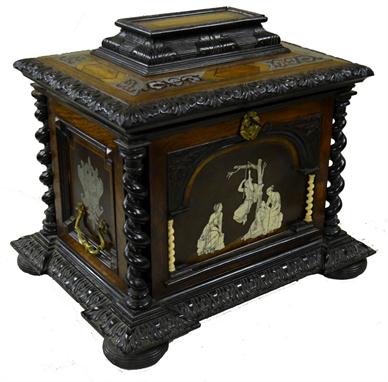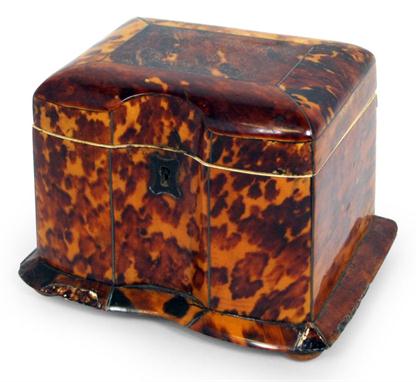We found 81455 price guide item(s) matching your search
There are 81455 lots that match your search criteria. Subscribe now to get instant access to the full price guide service.
Click here to subscribe- List
- Grid
-
81455 item(s)/page
A George III tortoiseshell veneered and ivory strung tea caddy, late 18th century, of decagonal section, the pagoda top rising to a marine ivory bun finial, the front inset with a monogram engraved silver plated copper disc, the interior with (later) metal lining and conforming subsidiary cover, 12.5cm high, 11.5cm wide
Sam. Atfield, Brentford, a walnut Queen Anne style miniature longcase clock the eight-day duration, five-pillar movement striking the hours on a bell with an outside countwheel, the eight-inch square brass dial having a raised silvered chapter ring engraved with black Roman numerals, meeting-arrowhead half-hour markings and signed Sam Atfield, Brentford either side of VI o’clock, with a matted dial centre and four cast brass floral spandrels to the corners with floriate engraving between, the walnut veneered case with a caddy top and turned columns to the hood, beaded moulding to the trunk door and crossbanding to the base, the backboard bearing a torn label stamped ‘Upjohn W, Maker, South Street’, height 182cm.* Samuel Atfield is unrecorded although a James Atfield is known working in Brentford in the mid 18th century. * William Upjohn is recorded working in Fore Street, Exeter in the late 18th century before moving to Southgate Street in circa 1800, having retired in 1803 he moved to London where he died in 1812.
Nathaniel Brown, Manchester, an 18th century longcase clock the eight-day duration movement striking the hours on a bell, the twelve-inch square brass dial with a raised chapter ring engraved with black Roman numerals, Arabic five-minute outer numerals, flame half-hour markings and the makers name Nathl. Brown, Manchester, with cast-brass female-head spandrels the matted dial centre with a subsidiary seconds dial, date aperture and engraved with foliate decoration, with decorative blued steel hands, the oak case with crossbanding to the shaped trunk door, base and hood door, the caddy top hood with two brass ball-and-spire finials, full pillars to the front with giltwood capitals and a fretwork frieze below the top moulding, standing on bracket feet, height 218cm.* Nathaniel Brown is recorded as working in Manchester from circa 1750 until circa 1800.
John Carlyon, Falmouth, an 18th century oak longcase clock the eight-day duration movement striking the hours on a bell, with the twelve-inch break-arch dial having a raised chapter ring engraved with black Roman numerals, Arabic five-minute outer numerals, fleur-de-lys half-hour markings and engraved either side of VI o’clock with the makers name John Carlyon, Falmouth, the matted centre with a subsidiary seconds dial and date aperture with engraved foliate decorative surround surmounted by a ho-ho bird, with wheat-ear border engraving , decorative blued steel hands and cast-brass urn spandrels to the four corners, the arch with a silvered boss engraved with a depiction of the sun, the oak case with a break-arch trunk door, turned three-quarter columns to the caddy-top hood with the plain base standing on bracket feet, height 226 cms.* John Carlyon is recorded as working in Falmouth in the early 18th century having married Ann Jenkins in 1729. He put his name to a marriage bond in 1740.
William Webster, London, a walnut bracket clock with an eight-day duration, double-fusee, five-pillar movement striking the hours on a bell, converted from verge escapement to anchor escapement, the backplate engraved with C-scroll decoration and the makers name Wm Webster, Exchange Alley, London, the eight-inch square silvered dial en-graved with a repeat of the makers name, with black Roman numerals, Arabic five-minute markings, strike/silent to the top left-hand corner and with decorative blued steel hands, the later 17th century style case with a caddy-top, cast brass mounts and brass carrying handle, height 44cm (inc. handle)
A 19th Century Continental rosewood casket in the Byzantine manner, with moulded caddy top and hinged lid above front panel inlaid with classical female (one on a swing), flanked by ivory twist pillars and with corner twist columns, on ringed-turned compressed bun feet, foliate carved rims, ebonised overall and veneered in amboyna, rosewood, silver and walnut, brass side handles and inlaid lion-mask inlays. 48cm high x 50cm wide x 38cm deep
"Two Walker & Hall silver gilt and enamel coffee spoons; a Norwegian tea caddy spoon, marked Orbech Karsavad, Texas; a crested spoon, `Fide et Fiducia`; a spoon with horse finial; a small pair of sugar tongs; and a silver salt, various dates and makers, 90grs approx. of weighable silver (7) "
Silver, comprising; a pair of sugar tongs, with cast and pierced decoration, probably London circa 1784, a pair of Irish stylised fiddle pattern sugar tongs, Dublin 1836, a pair of small sugar tongs, Sheffield 1936, a pair of scissor action sugar nips, circa 1800, a caddy spoon, with engraved decoration, Sheffield 1902 and another caddy spoon, by Joseph Willmore, Birmingham 1819, weight 165 gms.
Two silver decanter labels detailed Gin and Brandy, another decanter label detailed Whiskey (unmarked), a plated on copper caddy spoon, designed as a jockey`s cap, a plated five piece condiment set, with three condiment spoons, cased, a plated baluster shaped hot water jug, four silver spoons and a pair of silver sugar tongs.
Silver, comprising; a caddy spoon, the handle formed as the Lincoln Imp, Birmingham 1936, two further caddy spoons, a set of six coffee spoons, Sheffield 1926, three coffee spoons with apostle figure terminals, Chester 1902, three coffee spoons with thistle terminals and five further spoons, including a Foreign spoon detailed 830 S, weight 185 gms.
Silver, comprising; a crumb scoop with an ivory handle, London 1912, a pair of sugar tongs, with cast and pierced decoration, circa 1790, a caddy spoon with a plain fig shaped bowl, probably London 1807, six teaspoons, the finials with plumes and initials and three coffee spoons, Birmingham 1899, gross weight 410 gms.
A silver sovereign case, with engraved decoration, Birmingham 1895, two silver tea caddy spoons, a base metal tea caddy spoon, a gilt metal propelling pencil, a silver handled shoe horn, London 1906, a silver handled button hook in a matching design, two plated skewers with loop shaped handles and a silver handled manicure implement.
-
81455 item(s)/page



















































